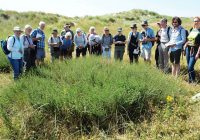Dr Phil Smith’s Wildlife Notes
July 2017
At last a return to “normal” British weather saw measurable rainfall on about 12 days, including the first really wet day for over a year on 21st. This freshened up the natural vegetation and was a boon to local growers and gardeners but had little impact on the sand-dune water-table due to high rates of evaporation at this time of year.
July is usually a great month for wildlife along the coast and this one was no exception, though the early season meant things were already looking rather autumnal by the month’s end. The Devil’s Hole blowout at Ravenmeols is a must in high summer, treats on 1st including the first flowering Grass-of-Parnassus and thousands of Marsh Helleborines. Shocking pink Pyramidal Orchids lined the dune ridges to the west. As usual, Northern Dune Tiger Beetles scurried about on the bare sand slopes, while two spectacular Dark Green Fritillaries and a Spiked Shield-bug added further interest. Walking back to the car at the end of Range Lane, I checked the site of the Ringlet colony found in June. Sure enough, there were still 15 in the long grass, though a few weeks later none was to be seen. The two ponds in a nearby field were also lined by Marsh Helleborines but the main surprise here was an enormous colony of Yellow Bartsia, a mainly southern plant that is scarce in the northwest. Later in the month, a Landscape Partnership guided walk to the iconic Devil’s Hole attracted 32 participants to this spectacular landscape feature with its remarkable wildlife. Their reaction was suitably positive.
On 4th, as many as 25 volunteers turned out for the Biodiverse Society’s Bioblitz on Birkdale Green Beach. Results circulated later showed that over 550 species of plants and animals were recorded, including 113 moths caught at night in light-traps and then released after being identified. Despite less than ideal weather conditions, an expert reported 69 different flies, including coastal specialists, rarities and some new to the Sefton Coast. These findings add to the already sky-high reputation of the Green Beach for its flora and fauna.
An early July trip to the Pinfold area of Ainsdale National Nature Reserve targeted the rare Forester moth at one of its key breeding sites in the region. I counted 17 shimmering green adults mostly on Ragwort flowers, an important nectar source for many insects in mid to late summer. All three of the Sefton Coast’s grasshoppers, eight different butterflies and seven dragonflies added to my enjoyment of this outstanding habitat.
Another July highlight came on 9th when Patricia Lockwood and I led a guided walk to Crosby Coastal Park for the Botanical Society of Britain & Ireland and Lancashire Botany Group. Twenty enthusiasts came from as far away as London to appreciate a wealth of plantlife, over 360 species having been recorded for the park. The main targets included five different Evening-primroses, the largest colony of Isle of Man Cabbage in the country and the very rare Dune Wormwood. We were also blown away by sheets of Sea Holly on which were growing over 300 spikes of the parasitic Common Broomrape, normally only seen in ones and twos.
A couple of days later, Pat showed me a superb population of about 160 Dune Helleborines flowering on the National Trust estate near Blundell Avenue. A little later, the same area produced a smaller number of the rather similar Green-flowered Helleborine. A regional rarity, the latter also turned up at Mere Sands Wood Nature Reserve, where I was shown five flower-spikes after a guided dragonfly walk on 15th. It was cloudy all afternoon and yet we still found six species of dragonflies. Some were netted and examined in the hand with the aid of an illuminating magnifier that demonstrated the wonderful colours and intricate structure of these ancient insects, much older than the Dinosaurs.
For our main botanical survey this summer, Patricia and I chose the Common Wintergreen a regionally rare plant found mainly in Scotland. It was last studied here a decade ago when ten colonies were recorded; this time we located 17, two being on the National Trust estate with the rest at Ainsdale Sand Dunes National Nature Reserve. Here it is mostly associated with firebreaks or small clearings in the pinewoods where the soil has been acidified by conifer needles producing extremely low soil pHs, often between 3 and 4. In total, we counted about 10,600 plants, a significant increase on the previous estimate. Nevertheless, some of the 2007 populations were not refound, apparently lost to overshading by dense birch regeneration.
Another fascinating month on the Sefton Coast ended with a massive hatch of red and black Six-spot Burnet moths in the dunes. I counted 13 on one Ragwort plant at Ravenmeols, while in the Devil’s Hole there were dozens nectaring on Water Mint.




